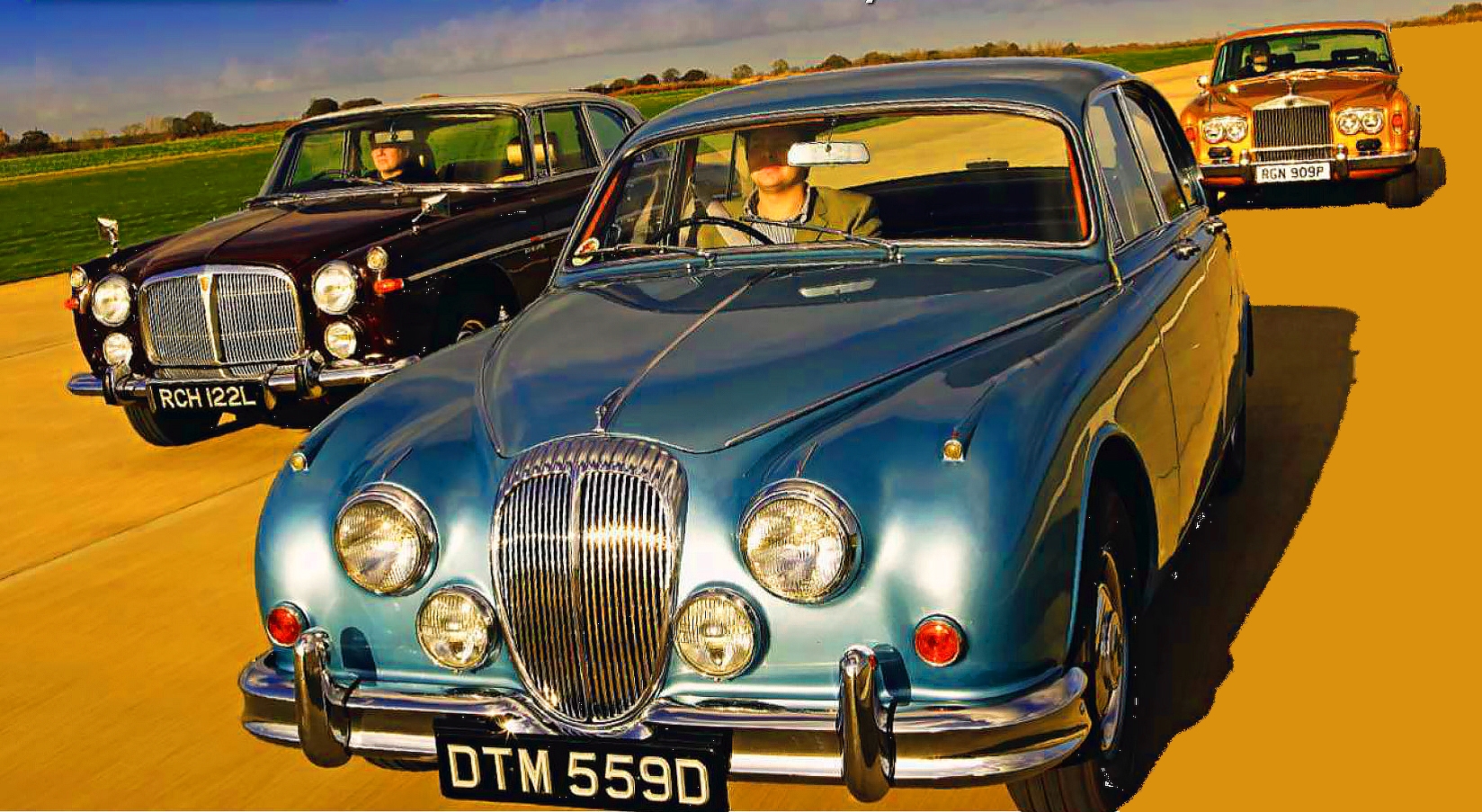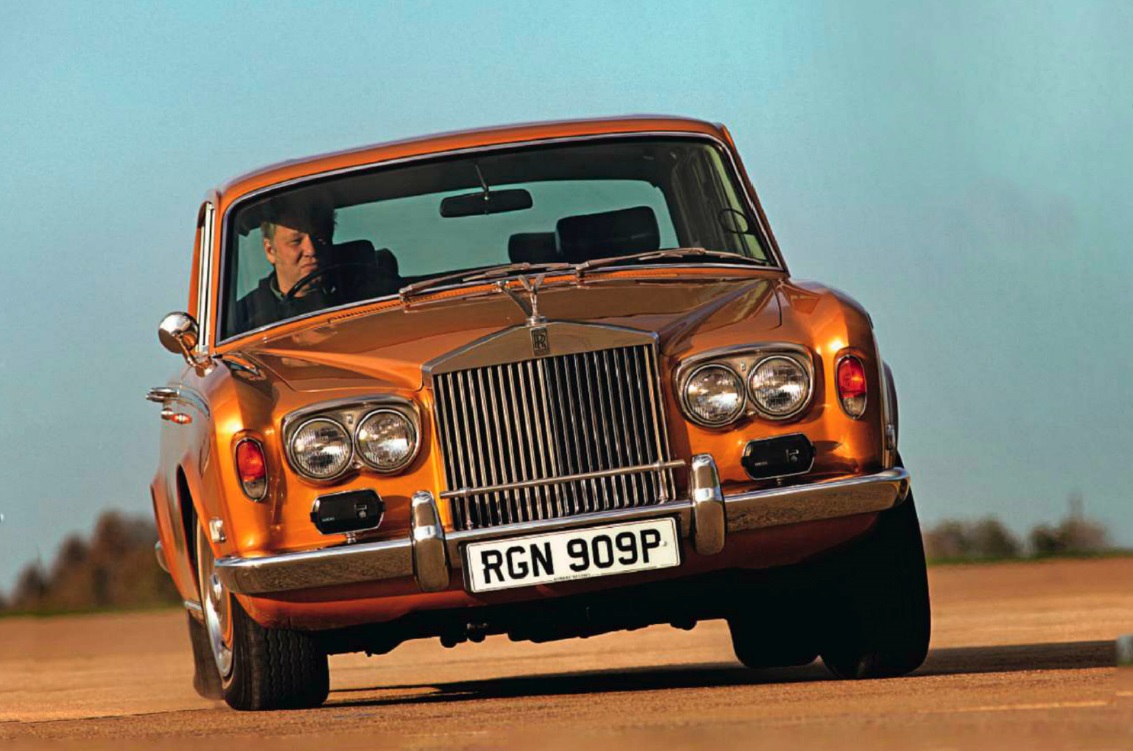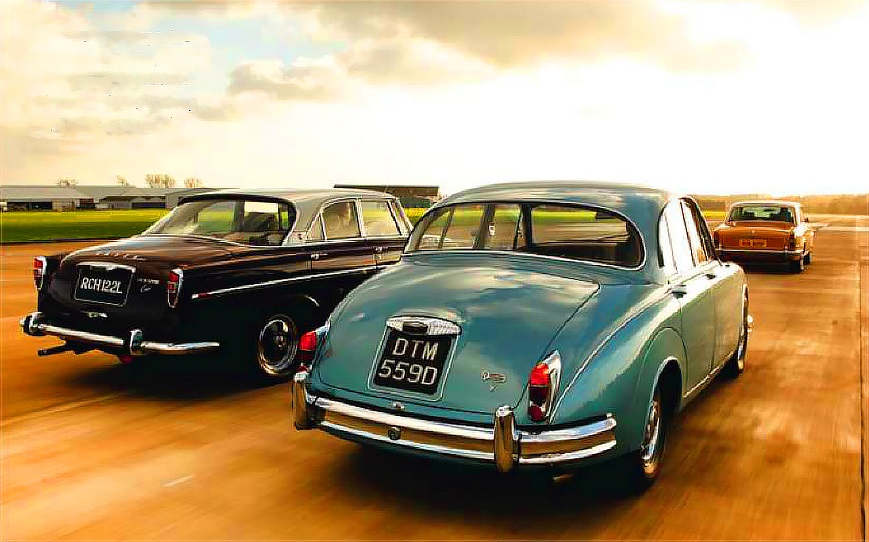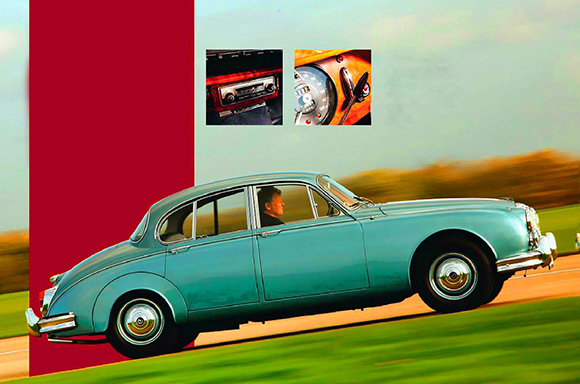
Power to the people. Once super-expensive, the Rolls-Royce Silver Shadow is a bargain buy today. Martin Buckley finds out if its V8 rivals from Rover 3.5 Litre Coupe и and Daimler V8-250 can keep up. Photography – Tony Baker. Shadow corners with plenty of roll, but the grip is tenacious. Below: superbly preserved Ebony hide; featured car boasts period Dictaphone in the driver’s footwell and dash-mounted cruise control.
In the late 1960s, a world where old certainties had yet to be shaken – in the realm of motor cars as well as socially – most people would have told you, when canvassed in the street, that a Rolls-Royce Silver Shadow probably was ‘The Best Car in the World’. It would certainly have been absurd to suggest that a Rover 3.5 Litre Coupe or a Daimler V8-250 were acceptable substitutes for one.

Price alone placed the cars in entirely different spheres of influence. ‘The Rover and the Daimler – internal V8 rivals in the same British Leyland stable from 1967 – were bought by accountants and bank managers who saw them-selves as a cut above Ford Zodiac ownership. Both were carefully priced to come in at just the right side of Harold Wilson’s £2000 limit, over which company cars were subject to a higher rate of Purchase Tax.

By 1968 – when all three cars were in production – we can assume that the typical Shadow buyer could have afforded to be fairly sanguine about what portion of the £8000 cost of his car went to the Treasury. In fact, the Purchase Tax alone on a standard Silver Shadow (as opposed to a long-wheelbase or a two-door Mulliner Park Ward Coupe) would have bought a new Rover Coupe or a Daimler V8 outright. If the Rolls had an international reputation, the Rover and Daimler were built to satisfy an almost purely local need for a sensibly sized luxury car with tastefully English middle-class values in its finish and appointments. Only in their deployment of modern, powerful V8 engines had either of these designs moved on significantly from the values of the late 1950s.
Test-drive 2014 old cars – Rolls-Royce Silver Shadow vs Rover 3.5 Litre Coupe and Daimler V8-250
 The 1962 2 1/2-litre Daimler, based on the Jaguar Mk2 shell, was the first offspring of Sir William Lyons’ acquisition of Daimler in 1960. Slipping neatly between the SP250 sports car and the big Majestic Major, it was a natural replacement for the old Conquest and Century’. Fluted grille apart, this was more than a piece of cynical badge-engineering. Its 2.5-litre, 140bhp V8 – lighter, shorter and higher-revving than the XK unit – gave it an identity entirely separate from its Jaguar siblings. Its more favourable weight distribution meant better handling and the free-breathing efficiency of Edward Turner’s hemispherical combustion chambers gave the potential for improved fuel consumption and a higher top speed than the leisurely 2.4-litre Jaguar. The model was popular, so for Earls Court in 1967 a mildly updated slim-bumper version appeared, rebadged V8-250 and incorporating Maries Varamatic power steering and a four-speed manual ’box as (desirable) options.
The 1962 2 1/2-litre Daimler, based on the Jaguar Mk2 shell, was the first offspring of Sir William Lyons’ acquisition of Daimler in 1960. Slipping neatly between the SP250 sports car and the big Majestic Major, it was a natural replacement for the old Conquest and Century’. Fluted grille apart, this was more than a piece of cynical badge-engineering. Its 2.5-litre, 140bhp V8 – lighter, shorter and higher-revving than the XK unit – gave it an identity entirely separate from its Jaguar siblings. Its more favourable weight distribution meant better handling and the free-breathing efficiency of Edward Turner’s hemispherical combustion chambers gave the potential for improved fuel consumption and a higher top speed than the leisurely 2.4-litre Jaguar. The model was popular, so for Earls Court in 1967 a mildly updated slim-bumper version appeared, rebadged V8-250 and incorporating Maries Varamatic power steering and a four-speed manual ’box as (desirable) options.
At the same show, Rover launched its 3.5-litre P5B, a revitalised version of the by-then nine- year-old P5. Available as a saloon or Coupe (the latter with lower roofline and half-frame doors), these flagship Rovers were the firm’s first unitary cars with a reputation, in original 3-litre ‘F’-head six-cylinder form, for staid refinement and conspicuously ponderous handling.
The internal P5B designation stood for Buick. In an uncharacteristically bold move, Rover had taken GM’s orphaned light-alloy V8 of the early ’60s and re-engineered it for the P5, giving an instant additional 40 bhp and 50 lb ft of torque with predictably dramatic effects on straight- line speed and, best of all, acceleration. A massive 7 seconds was lopped off the 0-60mph dash, lifting the car into an entirely new performance class despite the fact that it was only available as an auto. Because the V8 was 2001b lighter than the straight-six, the handling was better, too.
Production lasted until 1973, to the tune of 20 000 cars, and the big Rovers became a part of British public life as government ministerial transport through to the early ’80s. The final V8-250s, meanwhile, were built in 1969 and were significant in that they were the last cars with a distinctive Daimler identity’.
Launched in 1965, the Shadow had under-gone dozens of small improvements by the early ’70s, the major ones being a larger 6.7-litre version of its aluminium V8 engine and a more modern GM three-speed automatic. Rolls- Royce still made its own nuts anti bolts, but was not above adopting other makers parts or ideas. Even the silky V8, first seen in 6.3-litre form in the ’59 Cloud II, is thought to have been a thinly disguised interpretation of a Cadillac unit.
The Standard Steel four-door Shadow – its body was built in Swindon by Pressed Steel, alongside all manner of proletarian BMC runabouts – was in a highly exclusive group of vehicles priced at more than £5000 in the UK. Only a Rolls Phantom, a Mercedes 600 or a Monteverdi cost more by the end of the ’60s.
In many respects, the high cost of the Rolls- Royce (or the much rarer Bentley T Series) was justified. In matters of refinement, detail finish and its appetite for effortless long-distance travel with four or five people aboard, it set an international standard of excellence approached by only one or two other cars.
Some 45 years on, that figure of £8000 takes on a new relevance because that just happens to be roughly the kind of money that will capture you decent (but not perfect) examples of all three cars today. As luxurious British V8s, with the presence and sufficient pace to keep up with most of the younger traffic around them, the Daimler and Rover may well appear on the same buyer’s shortlist as a Silver Shadow in a way they never could have when they were new.
The mint examples in this trio would probably set you back nearer £20 000 each. The blue Daimler is a timewarp deep-bumper model with auto ’box but no power steering and just 25,000 miles to its name, after only recently emerging from long-term hibernation. The Rover has covered 55,000 miles and is in lovely order, having had a lot of money lavished on refurbishment; these are not cheap cars to restore. The 36,000-mile Regency Bronze Shadow is from 1976 and is thus a very late ‘flared arch’ car.
At rest, the Daimler is the most obviously antique of the three, its elegantly rounded lines and compact dimensions instantly identifying it as a car from the Jaguar family and a product of the 1950s. The Shadow, much longer and more sheer-sided, is a fabulously understated piece of big-car architecture – as long as you can ignore the implications of its famous radiator.
From top: hugely spacious and luxurious cabin; serene progress; Daimler looks rakish beside plump Rover and upright Rolls.
BUYER’S CHECKLIST – Rolls-Royce Silver Shadow
• Shadows rust more slowly than many contemporary saloons. Wheel-arches are the first areas to show signs of problems and sills/floors (including boot) should be checked. Some panels are aluminium.
• The high-pressure braking system is a well- known source of expensive problems. The brake-pressure lights on the dash should go out quickly after the car has been started; you could face a £2-3k bill to sort the system with new accumulators and associated pipework. To check if the self-levelling rear suspension is working, open one of the rear doors with the engine running and watch to see if the car adjusts its ride height.
• Engines are robust, yet not immune to problems. They shouldn’t smoke, but leaks are not uncommon and any knocks could be evidence of corroded cylinder liners. The three-speed GM400 box is superb and rarely gives problems; the earlier four-speed is a little more fragile and parts can be costly.
• Never was the cliche ‘buy the best can you can afford’ more apt than with a Shadow: projects are not viable in terms of expense or within the technical capabilities of a keen amateur. Service history is important. Parts are easy to get and not always as expensive as you might think, particularly if you use one of the specialist Rolls-Royce breakers.
• The interior is the glory of these cars and, as long as water has not been allowed to get in, they last fairly well due to the high quality of the materials used. Check all the electrics work, including the powered front seats.
PURCHASE TAX ALONE ON A SHADOW WOULD HAVE BOUGHT A ROVER OR DAIMLER OUTRIGHT
The Rover sits between the two in visual appeal, its squat roofline and raffish RoStyle wheels giving a surprisingly masculine impression compared to the matronly saloon version. I enjoy the rear view of the Rover, with those minimalist tail-lights on either side of the classic oversized numberplate. Thinking about it, they all look great from the back: the Daimler pert and sensual, the Shadow’s gently curved bootlid leading the eye towards the wide rear window and those comforting views of the elegant furniture on the other side of the glass.
A thread that links these three is the timeless appeal of a good V8: the inherent smoothness, even tickover, effortless torque and a certain sound. The Daimler’s alternating syncopation is urgent and throaty and you could not mistake it for anything else. The Rover sounds lazier, but is equally appealing in its refinement, while the Rolls-Royce merely hints at the configuration of its cylinders. It is totally silken and subtle, with a much smoother – yet also more responsive – gearchange. The Borg-Warner autos in the other cars are fine under light loads, but jerky when asked to change ratios at higher revs.
Daimler is most obviously a product of the 1950s, in both shape and detailing. Below: beautifully finished cabin bridges the luxury gap between Rover and Rolls; good handling, but manual steering is heavy

BUYER’S CHECKLIST – Daimler V8-250
• The Daimler V8 is almost as rugged as the Jaguar six! It should sound sweet and smooth, showing 15psi oil pressure at tickover, 40psi at 40mph in top. If it’s smoky, suspect worn valve guides; if it runs hot or loses coolant, it may have blocked waterways.
• The Daimler has all of the rust problems associated with the Jaguar Mk2, so check arches, valances, the ‘crow’s feet’ inside the front wings and sills, particularly the inners.
• At the back, it’s important to remove the rear bench to look at the seat pan and, beneath, the spring-hanger box members. Parts for these cars are freely available.
• Power steering is desirable (make sure the box doesn’t leak) and few cars had a manual four-speed ’box, although the Daimler is well suited to the reliable Borg-Warner 35 auto.
• It’s hard to beat an original low-mileage interior with all the factory finishes, but good results can be achieved with remanufactured parts and almost everything can be found.
In theory, the Rover and the Rolls-Royce have surprisingly similar performance, with 0-60mph in around 10 seconds and 115mph top speeds. In practice the Shadow feels faster, particularly from rest when a gentle touch on the throttle sends it romping away with an imperious lift of its nose. Motor, testing the Shadow in ’73, called this sensation of muscular refinement ‘power and dignity in noble union’, which describes perfectly the sensation of having nearly 50001b of luxury under such effortless control.
Cruising at 70, 80, 90 or even 100 mph you sit in relative silence, able to hear the creaking of the leather. Both the Rover and the Daimler sound pleasing under hard acceleration, but are beginning to have wind noise problems at those sorts of speeds and the Daimler in particular feels hideously low-geared by modern standards, even if its beautifully balanced and eager engine is quite happy to spin to its 6500rpm limit.

All three are lovely’ places to be and would be prohibitively expensive to retrim: these are cars for which the condition of the interior runs the bodywork a close second when inspecting with a view to buy. Naturally the detailing, finish and materials used inside the Rolls-Royce are in a different league, from the deep reflections in the veneers and the exquisite actions of all of the switches to the delightful precision of the electrically assisted column gearchange. From in here the world is a better place, but the Rover and the Daimler – with their armrests and picnic tables – do give you something of that Rolls feeling in terms of smell and general ambience, if not space: both are quite pinched inside and are no longer big cars in modern terms. The Shadow is much more spacious, with such refinements as electric windows, rear footrests and powerful heating/demisting that makes it much handier and more modern-feeling to use regularly. The fat rear pillars give a feeling of privacy inside.
The P5B Coupe facia has a rational binnacle, with minor gauges sweeping up underneath and the remainder of the dash set well back in a wave of dull-finish wood that looks more like early Habitat than Edwardian drawing room. It’s nicely made, in a more substantial way than the Daimler, but fans of the earlier 3-litre P5 prefer the detailing of their cars. The Daimler is almost pure Mk2 Jaguar, but with a split front bench seat.
The requirements of the classic buyer have thrown together a once disparate trio. Above: P5B steps off the line smartly, but struggles on twisty roads.
OUT OF TOWN, THEY ARE ABOUT GETTING ALONG BRISKLY AND UNOBTRUSIVELY
All three are wieldy town cars, the Daimler managing surprisingly well without power steering (once on the move) because of its lighter engine. The Rolls has an amazing turning circle for its size – it never leaves you feeling embarrassed or wishing you were driving something else – plus superbly powerful and progressive four-wheel discs, working on that notoriously expensive to fix high-pressure system licensed from Citroen. Not that there is anything inherently at fault with the conventional power brakes of either the Rover or the Daimler.
Out of town, they are about getting along briskly and unobtrusively, but all have steering problems when measured against anything remotely modern. Any more than brisk motoring tends to upset your passengers and alarm other drivers in terms of roll angles and scrubbing tyres. To enjoy them, you must develop the right attitude, almost learning to drive again if you have only been using current machinery.
You develop a light touch for the Shadow, with its unashamedly feel-free power assistance. Soon, you’re getting along quite quickly, trusting that the front wheels are biting and placing the nose to the half foot rather than the inch. Only the Rolls has the torque to push its rear end significantly out of shape, and when it does you realise how essentially well balanced it is in its soft, floaty’ way. The Daimler rolls less than either Rover or Royce and makes overtures to being a sports saloon simply because it is physically smaller and more firmly sprung. The lack of assistance means more feel, but you could argue that the abundance of turns from lock to lock (nearly five) cancels out any advantage.
Rover’s solution was simply to make the steering really light and consequently imprecise, then make up for it by adopting surprisingly high gearing of two and a half turns lock-to-lock, the ratio quickening as more lock is applied. The result is a car in which you judge how hard you are cornering by the angle of lean rather than the feel through its massive steering wheel.
The PS is surprisingly firm and your bottom is isolated from the bumps by the opulence of its huge seats. The Daimler is similarly lively, but with much less resilient upholstery. The Shadow eclipses them both with a supple and expensive- feeling gait: bumps are heard more than felt.
Time and varying rates of attrition have merged and mutated perceptions of these classic British V8 luxury saloons. Shadows are still in relative abundance, not only because they had a long production life (the last Shadow IIs were built in 1980, with big bumpers and rack-and- pinion steering), but also because they tended to be maintained more carefully and were more exactingly built than any Rover or Daimler. Each Shadow took three months to create, whereas the P5B and V8-250 rolled off production lines in the Midlands like many other mass-produced cars. Correspondingly, a Shadow would prove both vastly more expensive to restore and significantly more costly to run (even putting aside fuel consumption issues at 10-12mpg) simply because it is bigger and much more complicated than the other two. And Shadows do rust.
Which is not to say that the Rover and the Daimler are cheap ’n’ cheerful cars to own. Both were from a period of thirsty, rust-prone first- generation unitary construction British saloons to which the rising fuel prices and salty winter roads of the 1970s were not kind. They were deeply out of fashion by the end of the decade, a time when driving old cars was still seen as eccentric rather than ‘cool’. Consequently, well-preserved original (or properly restored) Daimler V8s and Rover Coupes are in surprisingly short supply. The Daimler suffers all of the well-known rust problems of the Jaguar Mk2, but if anything the engine is more rugged and getting parts is no real problem. The Rover famously rusts around its rear pillars – visible with the rear doors open – and various P5B trim parts can be difficult and expensive to buy.
While the Daimler and the Rover rusted away, the Shadow was still riding high. Cast from your mind images of smoky old wedding cars and 1О-bob millionaire pub landlords. In the late ’60s and early ’70s, this was the ultimate luxury car if your interests favoured comfort and a flawless finish over any notions of driver appeal. Some big saloons were faster and many handled better than the first of the roly-poly Shadows, but as an all-round product, brimming with refinements and all kinds of small thoughtful details, it was a great ambassador for British craftsmanship and engineering. Critics of the car tended to be those who couldn’t afford one: huge waiting lists for the Shadow from its introduction demonstrated that Crewe had got the formula right for what, in many ways, was the first ‘modern’ Rolls-Royce, complete with independent suspension all round and an image focused on the owner-driver.
Personally, I still don’t believe there is any substitute for a Shadow if you can afford the running costs and feel at home with the image. If you can’t, you know what to do.

BUYER’S CHECKLIST – Rover 3.5 Litre Coupe
• Rust is the main enemy. Check sills, А-posts behind the front wheelarch splash panels, lower rear pillars, inner rear wings and the supporting legs under the boot floor.
• All outer panels bolt on. Some new parts are available, but they aren’t cheap. Check door bottoms, double-skinned scuttle, front wings around the lamps and rear wing seams.
• Rear bumpers are particularly vulnerable and finding a good second-hand one isn’t easy; repair or a costly remanufactured item is the only answer. Sill trims can disappear and the chromed RoStyle wheels are notoriously expensive and difficult to refurb.
• Interior problems such as split leather seams and tired wood and carpets will be obvious and not cheap to rectify.
• Mechanically P5Bs are rugged, but not without issues. Power-steering leaks can be expensive to sort and engines require regular oil changes to keep the hydraulic tappets quiet. V8s can develop leaks from the rear.
| Car | Rolls-Royce Silver Shadow | Rover 3.5 Litre Coupe | Daimler V8-250 |
| Made as | GB | GB | GB |
|
Sold |
1965-1977 | 1967-1973 | 1962-1969 |
| Number built | 16717 | 9099 | 17620 |
| Construction |
steel monocoque, with alloy bonnet, boot and doors |
all-steel monocoque |
steel monocoque |
| Engine |
all-alloy, ohv 6750cc 90° V8, twin SU HD8 carburettors |
all-alloy 3528cc 90° V8, twin SU carburettors |
all-alloy 2548cc ohv V8, twin SU carbs |
| Max power |
not disclosed |
151bhp @ 5200rpm |
140bhp @ 5800rpm |
| Max torque |
not disclosed | 201 lb ft @ 2750rpm | 155 lb ft @ 3600rpm |
| Transmission |
three-speed automatic, fluid coupling, RWD | three-speed Borg-Warner Type 35 automatic, RWD | Borg-Warner three-speed auto, RWD |
| Suspension |
independent, at front by double wishbones, anti-roll bar rear trailing arms; coil springs, telescopic dampers, automatic height control f/r |
front independent by torsion bars, anti-roll bar rear live axle, progressive- rate semi-elliptic leaf springs; telescopic dampers f/r |
front independent by wishbones, coil springs, anti-roll bar rear live axle, quarter-elliptic leaf springs, radius arms, Panhard rod; telescopic dampers f/r |
| Steering |
Saginaw power-assisted recirculating ball |
power-assisted recirculating ball |
Burman recirculating ball |
| Brakes |
powered Girling discs, twin calipers at front, with three independent circuits |
discs front, drums rear, with servo |
Dunlop discs, with servo |
| Measurements |
Length 16 ft 11 in (5169mm) Width 5ft 11 in (1803mm) Height 4ft 13 in (1518mm) Wheelbase 9ft 11 in (3035mm) |
Length 15ft 7in (4750mm) Width 5ft 11in (1791mm) Height 4ft 11in (1473mm) Wheelbase 9ft 2in (2807mm) |
Length 15ft 3in (4591mm) Width 5ft 6in (1695mm) Height 4ft 9in (1467mm) Wheelbase 8ft 11 in (2727mm) |
| Weight | 4660 lb (2067kg) |
3500 lb (1587kg) |
3046 lb (1381kg) |
| 0-60mph |
10.8 secs |
12.4 secs |
13.8 secs |
| Top speed |
115mph |
113mph |
112mph |
| Mpg |
10-15 |
17 |
17 |
| Price new |
£7790 |
£2270 2s 9d |
£1786 |
| Price now |
£7-20,000 |
£5-15,000 |
£7500 25,000 |





